Link: http://imanas.shanghai.nyu.edu/~yz4970/week7/audio-project/audio.html
Description:
Our project is called “shut up and listen” . It’s a collection of human voice and object sound. We invited some people to our interview and recorded the sound of the objects and the story of this object.

(main page)
Me and Val collaborated on this project and it turns out wonderful!
Process:
Inspiration/Ideas:
I was inspired by the videos Leon showed us during the class. I related some of them to the other videos I have watched. I like watching ” 10 essentials” interviews of GQ magazine where they interview celebrities about 10 essential things they cannot leave without and ask them to explain the story behind them. And personally, I am obsessed with listening to stories. I like when people are telling their own stories. The tones, the paces, and the tiniest details could be recorded to reflect the people’s emotions. So I came up with the idea of this project, which is interview people about the object they feel attached to and the story behind it.
 (my inspiration)
(my inspiration)
Audio:
Collecting Materials:
We almost started to collecting our materials right after we got the idea. I invited some of my friends to attend our interview. I recorded the sound of the object first and then ask them a few questions and the story of this object. We did these interview in the interviewees’ mother tone. In different languages and dialects: German, Chinese, English, Japanese… It’s very intriguing to see how they reveal their emotions subconsciously when speaking in their mother tone. And how wonderful they sound.
We used Tascam and shotgun microphone to record. And we did some of the interviews in the music room on 8th floor. It’s very quiet and the quality of the sound turns out really great.
Editting Materials:
We used Audacity to edit the materials we collected. I used some functions like fade-out and eliminate-noise to improve the quality of the audio. I also used different tracks to integrate the sound of the object and the interviewee’s voice. So they happen simultaneously. And when the volume is too high/low, I use Audacity to do minor changes. But I didn’t do very big changes to the volume because I’m afraid it will harm the quality of the audio.
Because I have to ask some necessary questions during the interview to keep the format of each audio consistent, my voice is also recorded in the audio. I used Audacity to edit them out.
Photoshop:
I took a picture of 7 white chairs in a white background and make it the background of our webpage. And during each interview we took pictures of the objects. Val did some photoshop to cut out the object and put these images to the background image.

(background image)
We want to keep these objects mysterious and keep people guessing what these objects are by listening to the sound of the object. So we add shadow to the image of the shadow and when u click it it will show.
 (one image of shadowed object)
(one image of shadowed object)
Webpage Design & Coding:
We wanted to keep the webpage simple and make people focus on the audio. So we only have one page and put everything there. Subtitles are so important for our project and we learned how to do subtitles in class. We did subtitles for every none-English audio. Also, we created some div boxes to put the control and the subtitles inside. And when you click the object, the div box will show. We did this using display:none and display:block function. I also learned how to use images as buttons to trigger other functions.
We set the font yellow so it looks like those in the old movies. And the images are shadowed at first, but when you click them, the real images will show. We did this by using innerHTML function. Everything is simple and clear.
Post-Moterm:
Our project went out really great and I think it met my goal. It expresses my ideas and is beautiful and clean.
Problems:
Subtitles:
I had difficulty with subtitles first. It will stay on the first subtitle that I assigned. Because instead of writing “if / else if” , I wrote ” if/ if” . So that java will only check the first condition.
Audios:
Because our time and environment conditions are very limited. So we did the interviews in different environments. Some of them sound better without any noise but some of them sound not that good. And the volume is not consistent either.
What I Learned:
- how to add subtitles on webpage
- how to use Tascam and shotgun microphone to record
- how to use Audacity
- how to choose the environment of a recording place
Future Development if Possible:
- To keep the audio quality consistent.
- To make this full screen.
- To create different interface when audio shows.





 (my inspiration)
(my inspiration)
 (one image of shadowed object)
(one image of shadowed object)